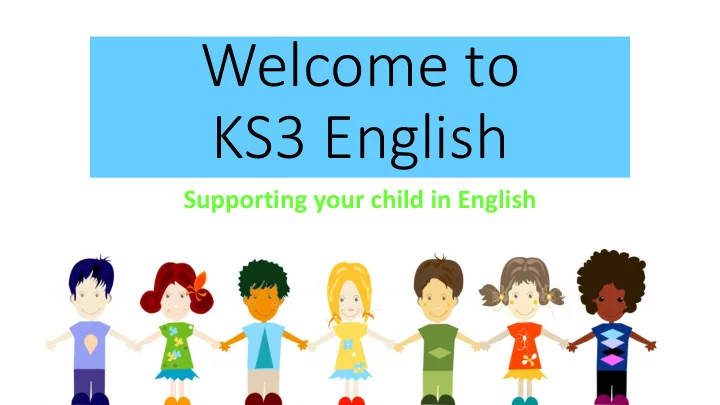

Welcome to KS3 English Supporting your child in English
Year 7 Autumn Into English and ‘Treasure Island’ Term Spring An Introduction to Shakespeare with Term a study of ‘The Tempest’ Summer Heroes and Villains Term
The rest of your KS3 Journey Year 9 Autumn ‘The Crucible’ Term 1 Autumn Non-Fiction Writing Year 8 Term 2 Spring ‘King Lear’ Autumn Gothic Horror Term 1 Term 1 Spring Autumn ‘Much Ado About Nothing’ Term 2 Term 2 Summer ‘The Speckled Band’ and revision Spring Dystopian Fiction Term Term 1 Spring Poetry Term 2 Summer ‘Pygmalion’ Term
Y7 Where do we Year 7 Autumn Term start? An Introduction to English • • • The Art of Storytelling and Reading is an introduction over two half terms to English at Secondary level. We begin with learning to write a formal report of reading habits. Your child will revise key terminology from primary school and learn how to use this independently - in research and in writing. We then move onto reading a range of fiction text extracts. From classics such as Alice’s Adventures in Wonderland to modern children’s fiction by David Walliams, students will learn about genre and how writers adapt their writing for different purposes. Your child will then use their understanding of genre to inform their own creative writing in different styles, culminating in a variety of short and extended creative writing pieces. Finally your child will be introduced to a range of modern and classic poetry. Learning how to read and understand the purpose of different texts, and how the writer has used language and structure to create that meaning.
Y8 Where do we Year 8 Autumn Term ‘Ghosts and Gothic’. • • • start? Ghosts and Gothic is an introduction and study over two half terms to the literary world of the ‘Gothic’. We begin by considering the genre of ghostly stories and establishing through a range of art, literature and fiction the ingredients that make up the gothic genre. We then move onto reading a range of pre 19 th Century gothic fiction text extracts. From classics such as Dracula by Bram Stoker to Mary Shelley’s Frankenstein . Students will reflect and analyse how the main protagonists are presented and compare how Dracula and the Monster in Frankenstein meet the expected conventions of the gothic genre. As a whole class, your child will then be supported to read and understand more modern gothic fiction in The Woman in Black by Susan Hill. Chapter by chapter students will consider the characters, setting and story; learning to analyse how different facets of the gothic genre are presented and their effect on the reader. Finally your child will demonstrate their understanding of the gothic genre by writing creatively in the style.
Y9 Where do we Year 9 Autumn Term ‘The Crucible’. start? Students will study The Crucible focusing on the conventions of a play, language, structure and context. Alongside this they will study a range of fiction and non-fiction extracts as a springboard to creative writing.
Every day you child is encouraged to read across the school. Ensure your child has a reading book with them all the time that they are keen to read. Article 31: Every child has the right to play and relax.
Accelerated Reader in Y7 and Y8 • Tested to establish a reading age at the beginning and end of the year. • Encourage reading for pleasure. • Quizzes. Rewards ✓ Based on words read… ✓ Quizzes Completed… ✓ Reading Millionaires!
What happens in your child’s English lesson? Peer Reading Independent Assessment learning Speaking and Writing Listening Silent work Discussion
Our Expectations in English ✓ We expect your child to take part. ✓ We expect your child to write as neatly as they can. ✓ We expect your child to respond positively to feedback. ✓ We expect your child to try their We may ask your child to re- best. do a piece of work that is not ✓ We expect your child to ask their best effort. questions if they are unsure.
How we help your child to make progress: These are the most successful parts of the work. The orange marks mean the spelling, I will positively welcome challenge so I punctuation or grammar is incorrect can develop my potential to the full. and needs changing. Work underlined in red is not quite right.
Homework – supporting your child at home TIPS! ✓ Create a quiet space for homework to take place. ✓ Discuss your child’s work with them. ✓ Use Class Charts ✓ Create reading time at home with your child. 3-4pm: The library is available every day to support your child.
Any ✓ Contact your child’s English teacher directly from the website. ✓ Contact KS3 English Lead: questions? k.ward@theregisschool.co.uk ✓ Contact Head of English s.gallant@theregisschool.co.uk Supporting your child in English
Recommend
More recommend